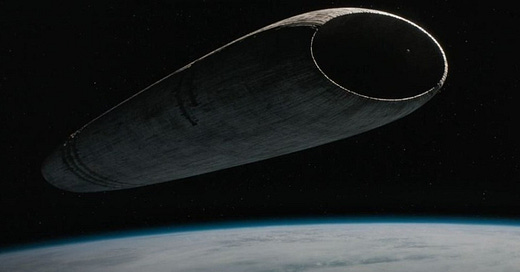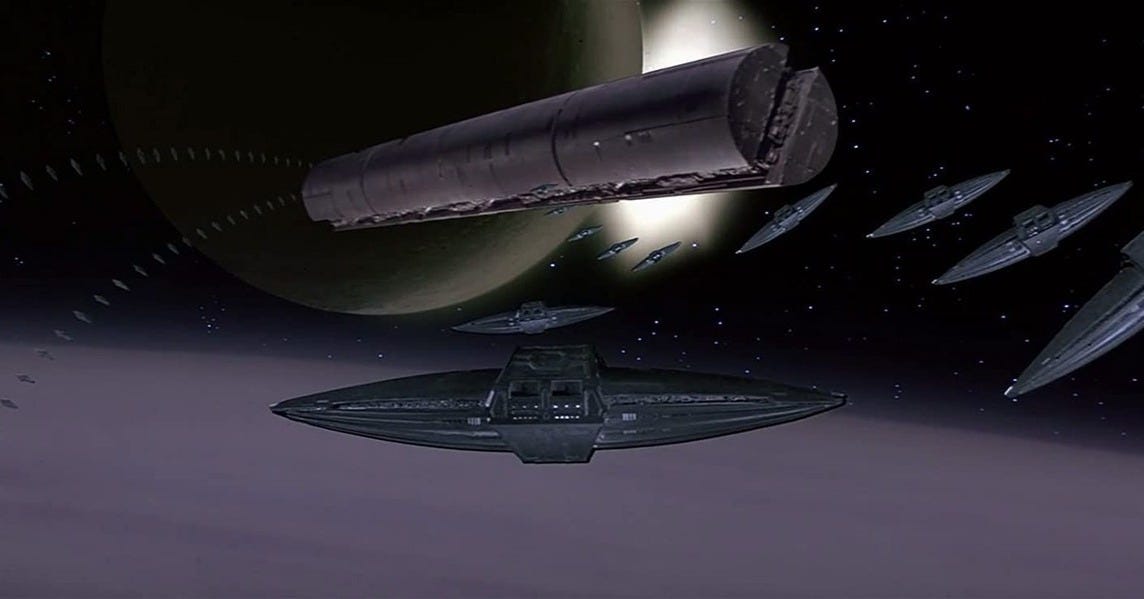Spaceships of Dune
Beyond Heighliners and No-ships - every starship imagined by Frank Herbert.
If there’s one thing that Dune is certainly not known for, it’s technical details.
While Star Trek fans can draw a warp core on the back of a napkin, and Star Wars fans debate the merits of different kyber crystals, we Dune fans are left with the likes of Mr. Holtzman and his field. The one that can power shields, fold space, and, I’m sure, toast bread if you have the right equipment.
And you know what? I wouldn’t have it any other way.
When it comes to spaceships, we get no detailed schematics. No lengthy explanations of engine specifications or hull materials. No diagrams of control panels or engineering decks. Just enough information to understand their function and significance to the story.
Why? Because in Herbert’s universe, technology is secondary to humanity.
The focus is on the people who use the technology, not the technology itself.
SPOILER WARNING: CONTENT FROM THE ORIGINAL 6 BOOKS
Propulsion Technologies
With that said, and admittedly, it’s taken six books, but we got just enough details to piece together that Dune spaceships rely on (at least) three distinct propulsion technologies.
Rockets
First, there's conventional rocket propulsion, evidenced by numerous references to burn marks and scorched earth where ships have landed or taken off.
The Guild lighter lifted in its noisy rumbling
— God Emperor of Dune (1981)
Teg's thoughts were in turmoil as he returned to Gammu from the Guildship. He stepped from the lighter at the black-charred edge of the Keep's private landing field and looked around him as though for the first time.
— Heretics of Dune (1984)
And yes, this even includes the highly advanced no-ships:
Charred ground, signs of a no-ship's lift-off.
— Heretics of Dune (1984)
And while Spice might remind you of cinnamon, apparently no-ship exhaust smells like garlic:
Something flashed overhead - trailing blue and red sparks. Another and another! The earth trembled. Teg inhaled through his nose: burned acid and a suggestion of garlic.
No-ships! Many of them!
— Heretics of Dune (1984)
Suspensors
Second, there’s suspensor technology, which provides (limited) anti-gravity capabilities.
Hey, if it’s good enough for the Baron Harkonnen to float around, it’s good enough for spaceships.
The only problem is the energy requirements - they’re huge. Not something smaller vessels could support.
On one occasion, Odrade notes that their ship was too small to perform a re-entry maneuver with suspensors:
It would use atmospherics to dampen its descent, she knew […] The pilot would be sparing of their suspensors on such a craft, saving energy.
— Heretics of Dune (1984)
Holtzman drive
Third, there's the Holtzman drive that enables space folding - the cornerstone of interstellar travel.
This technology is primarily used in Guild Heighliners and, in later books, no-ships, allowing instantaneous travel between star systems.
Speaking of which…
The Guild Heighliner: Backbone of Interstellar Travel
Undoubtedly the most iconic and most recognizable ship in all of Dune. The primary means of interstellar transportation, operated exclusively by the Spacing Guild.
They’re massive. Ginormous. I mean, really, really huge. Their sheer scale is so staggering that I’m struggling for words.
Just like Duke Leto when he tried to explain them to a young Paul Atreides:
"A Heighliner is truly big. Its hold will tuck all our frigates and transports into a little corner—we'll be just a small part of the ship's manifest."
I think most people imagine them as cylindrical containers (all the movies did) to which other ships get attached, carrier ships of sorts.
But interestingly, Heighliners also have dedicated passenger facilities. So even if you don’t have your own ship, you can just board the Heighliner directly.
In Dune Messiah, the Reverend Mother Mohiam awaits “on the heighliner’s reception bridge” while being served spice-coffee by a steward.
Less surprising and more obvious: it also has to have a cockpit, occupied by the spice-mutated Guild Navigators who use their limited prescience to safely fold space.
As we know, the monopoly on safe interstellar travel was the foundation of the Guild’s power within the empire.
If you want to learn more about that, I can only recommend the Dune Minute Podcast’s excellent episode from a few weeks ago:
🔒 In the full article:
Complete catalog of spacecraft mentioned in Frank Herbert's six Dune novels
Frigates, lighters, no-ships, monitors, crushers, troop carriers, scouts, shuttles, dump boxes, cargo ships, and hammerships
Detailed descriptions and canonical references for each vessel type
Evolution of spacecraft technology from Dune to Chapterhouse: Dune #no-ships
Notable moments featuring spacecraft in the series
Keep reading with a 7-day free trial
Subscribe to Dune Navigator to keep reading this post and get 7 days of free access to the full post archives.






